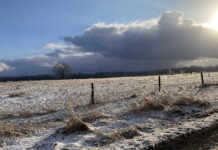One thing we can do on these cold and snowy winter days is think of warmer temperatures and plan for new forage seedings.
Spring will likely be here before we know it, and spending time now mapping out your plan will be time well spent.
Soil testing
If you do not have a current (within the last three years) soil test, make this a priority for those fields you intend to seed. A soil sample will provide you with pH, lime recommendation (if needed), and a fertilizer recommendation based on the previous crop and planned seeding.
Samples should be pulled as soon as conditions allow and mailed to a lab for analysis. Your agronomist or extension educator can assist you with sampling and interpretation of the lab analysis.
Soil pH and fertilizer
The pH is a measure of soil acidity. Depending upon your soil type, previous farming practices, and location the pH may be low and require the addition of lime to raise the pH to an acceptable level.
At a minimum, soil pH should be at least 6.0, preferably in the range of 6.5 to 6.8 for optimum forage production. If lime is required to adjust pH, make sure to use high-quality agricultural grade lime.
Be cautious about lime sources that are very low priced or claim to be too good to be true. Ideally, lime would be added at least six months prior to seeding to allow time for pH adjustment. If this is not possible, consider incorporating the lime into the soil.
Depending upon the type of forage you intend to plant and the results of your soil test, some amount of fertilizer may be needed. Your soil test will provide you with the amount of nitrogen, phosphorus, and potassium to apply.
There are “book values” available, but a soil test is the only way to truly know how much and what nutrients need applied. Adequate fertilizer and proper soil pH are the first steps in achieving a high-quality forage crop.
What to Plant? There are several things to consider when answering this question. What are your goals? Will you feed the forage to livestock? Will animals graze the forage? Do you intend to sell dry hay?
These are a few of the more common questions to evaluate before establishing a forage stand.
Many people think they need to plant alfalfa as their forage crop. This may be true, depending upon your goals and intended use. While alfalfa is an excellent crop that produces high quality feed, it is expensive to establish and maintain.
Alfalfa is commonly used for high producing dairy cattle. For most beef producers, a grass and clover mixed stand will do well and provide the nutrient requirements of cattle.
I encourage farmers to plant grass and clover species that are well-adapted to the area. These species perform well because they have been tested and proven over the years to persist.
Summary
Forages are an important component in the diet of livestock raised in Ohio. Before planting the first seed, take time to develop a plan based on your goals, intended use and experience. Make sure you review your soil test reports and add any lime and required nutrients to set yourself up for a successful forage crop.
Reach out to your local Ohio State University extension educator to assist with soil testing and interpretation and forage species selection based on your goals.













